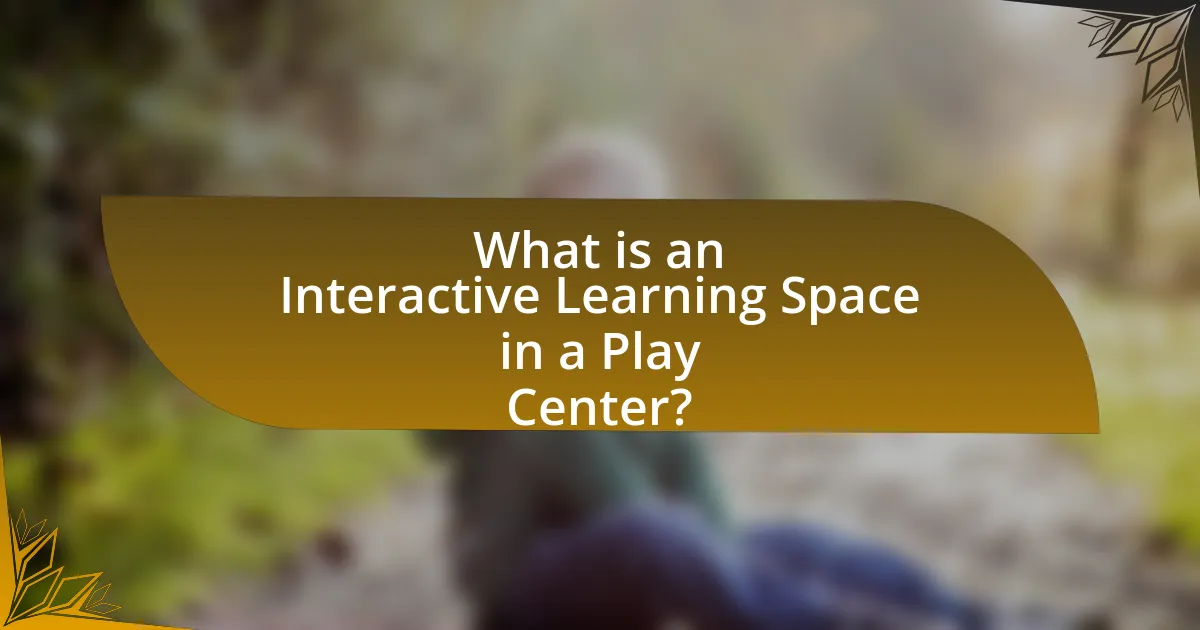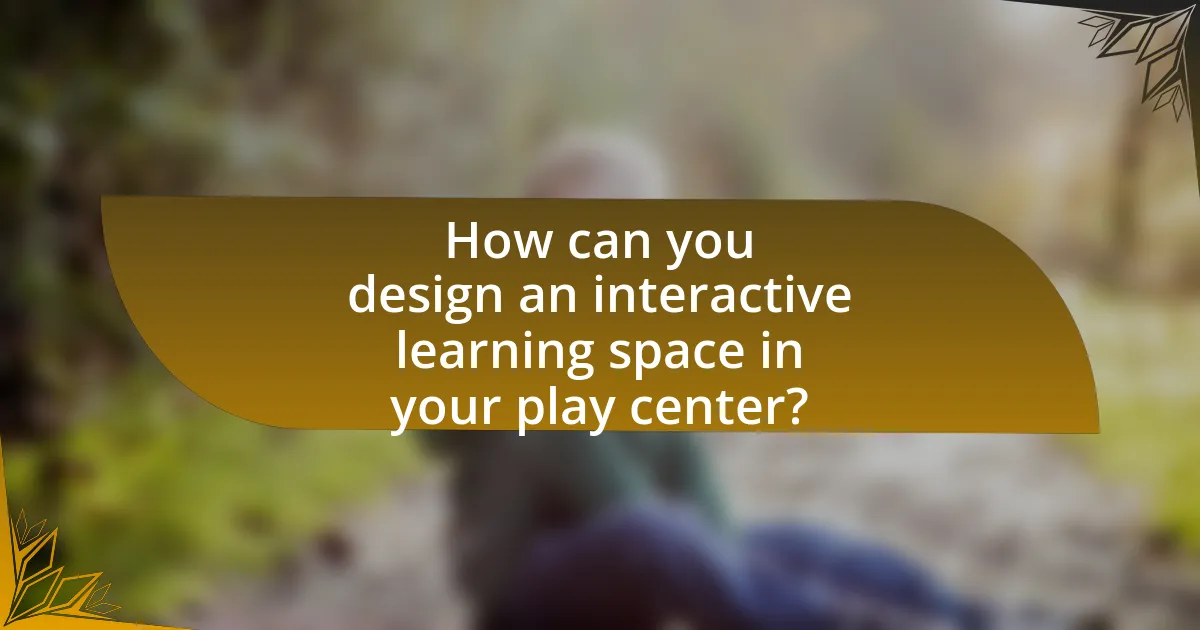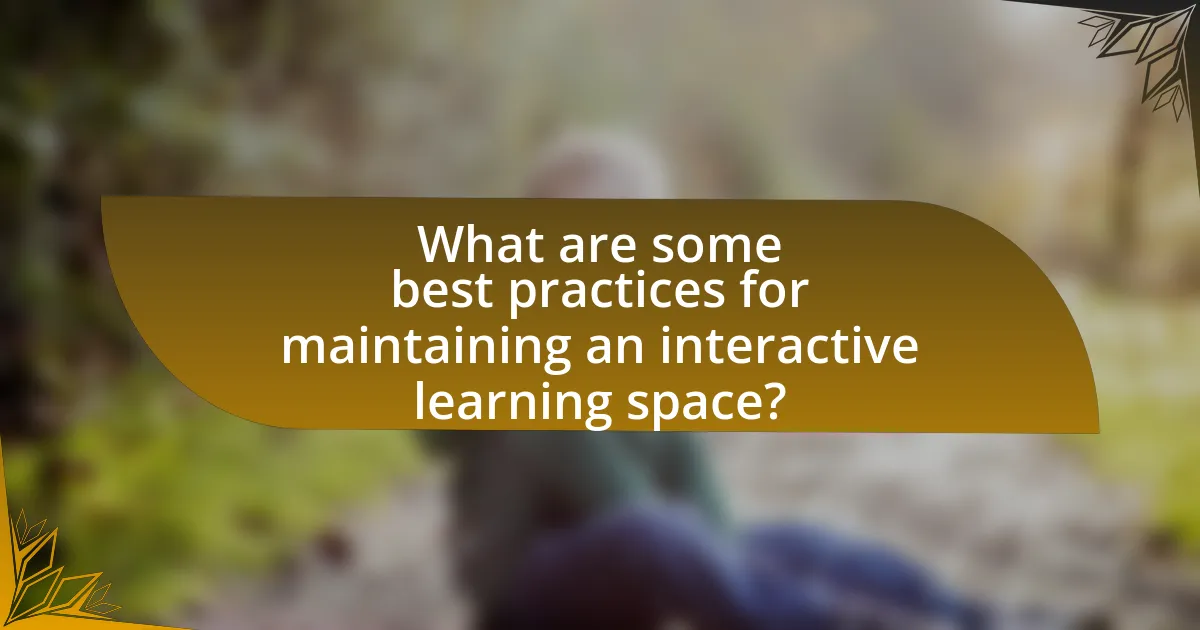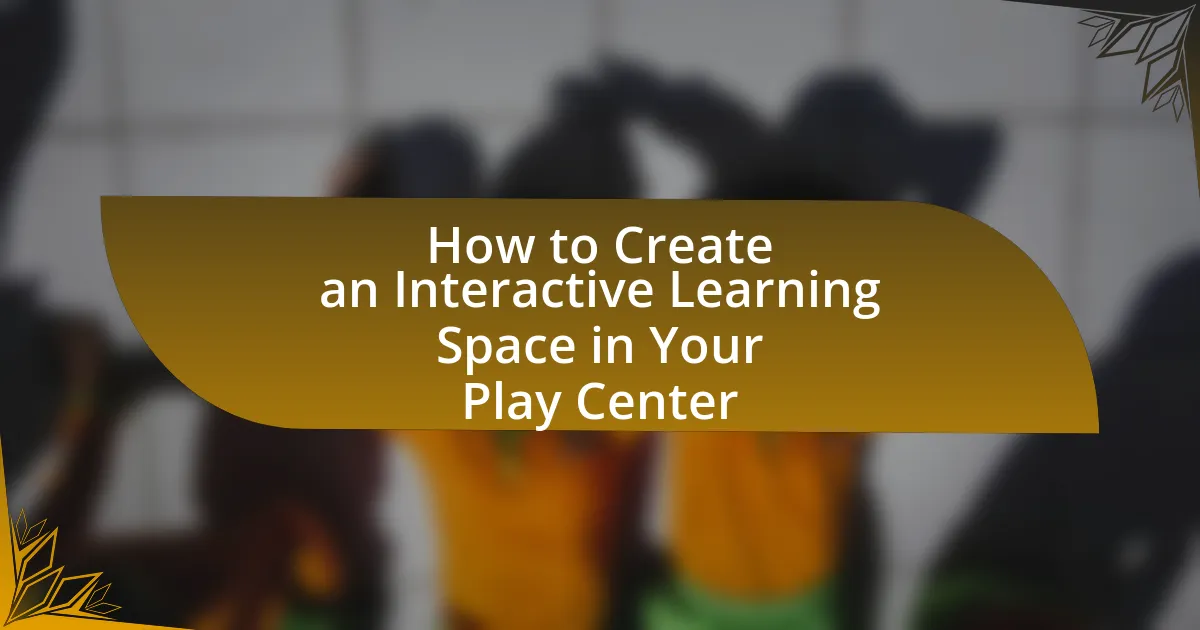An Interactive Learning Space in a Play Center is a specialized area designed to promote hands-on learning experiences for children, incorporating elements such as educational games, sensory activities, and collaborative projects. This article outlines the differences between interactive learning spaces and traditional play areas, emphasizing the importance of interactivity in enhancing cognitive, social, and emotional development. Key components of these spaces include flexible furniture, technology integration, and engaging resources, all aimed at fostering active participation and improving learning outcomes. The article also provides practical guidance on designing, maintaining, and assessing interactive learning environments, addressing common challenges and offering strategies for effective implementation.

What is an Interactive Learning Space in a Play Center?
An Interactive Learning Space in a Play Center is a designated area designed to facilitate hands-on, engaging learning experiences for children. These spaces typically incorporate various interactive elements such as educational games, sensory activities, and collaborative projects that promote cognitive, social, and emotional development. Research indicates that environments rich in interactive learning opportunities enhance children’s problem-solving skills and creativity, making them essential for effective early childhood education.
How does an interactive learning space differ from traditional play areas?
An interactive learning space differs from traditional play areas primarily in its focus on educational engagement and active participation. While traditional play areas often emphasize unstructured play and physical activity, interactive learning spaces are designed to facilitate cognitive development through hands-on activities, technology integration, and collaborative learning experiences. For example, interactive learning spaces may include digital tools, manipulatives, and themed environments that encourage problem-solving and critical thinking, whereas traditional play areas typically feature static equipment like swings and slides that do not promote these skills. This distinction highlights the educational purpose of interactive learning spaces, which aim to enhance learning outcomes through structured interaction and exploration.
What elements define an interactive learning space?
An interactive learning space is defined by elements such as flexibility, technology integration, collaborative furniture, and engaging resources. Flexibility allows for adaptable layouts that support various activities and group sizes, fostering dynamic learning experiences. Technology integration includes tools like interactive whiteboards and tablets, which enhance engagement and facilitate diverse learning methods. Collaborative furniture, such as movable tables and seating, encourages teamwork and communication among learners. Engaging resources, including hands-on materials and visual aids, stimulate curiosity and promote active participation. These elements collectively create an environment conducive to interactive learning, as supported by educational research indicating that such spaces improve student engagement and learning outcomes.
Why is interactivity important in a learning environment?
Interactivity is important in a learning environment because it enhances engagement and retention of information. Engaged learners are more likely to participate actively, which leads to deeper understanding and improved critical thinking skills. Research indicates that interactive learning methods, such as hands-on activities and collaborative projects, can increase retention rates by up to 75% compared to traditional lecture-based approaches. This demonstrates that interactivity not only fosters a more stimulating learning atmosphere but also significantly boosts educational outcomes.
What are the key components of an interactive learning space?
The key components of an interactive learning space include flexible furniture, technology integration, collaborative areas, and engaging resources. Flexible furniture allows for easy reconfiguration to support various activities and group sizes, enhancing adaptability. Technology integration, such as interactive whiteboards and tablets, facilitates dynamic learning experiences and access to digital resources. Collaborative areas promote teamwork and communication among learners, fostering social interaction. Engaging resources, including hands-on materials and visual aids, stimulate curiosity and support diverse learning styles. These components collectively create an environment conducive to active participation and effective learning.
How do physical layouts influence interaction?
Physical layouts significantly influence interaction by determining the flow of movement and accessibility within a space. For instance, open layouts encourage collaboration and communication among individuals, while closed or segmented spaces can create barriers to interaction. Research indicates that environments designed with flexible seating arrangements promote social engagement and active participation, as seen in studies conducted by the University of Salford, which found that classroom design can impact student engagement and learning outcomes. Thus, the arrangement of furniture and spatial organization directly affects how individuals interact, collaborate, and engage in activities within a learning environment.
What types of materials and resources should be included?
To create an interactive learning space in a play center, essential materials and resources include educational toys, art supplies, sensory materials, and technology tools. Educational toys, such as building blocks and puzzles, promote cognitive development and problem-solving skills. Art supplies like crayons, paper, and paint encourage creativity and self-expression. Sensory materials, including sand, water, and textured items, enhance sensory exploration and fine motor skills. Technology tools, such as tablets or interactive whiteboards, can facilitate digital learning experiences. Research indicates that diverse materials support various learning styles and developmental needs, making them crucial for an effective interactive learning environment.
What benefits does an interactive learning space provide for children?
An interactive learning space provides children with enhanced engagement and improved learning outcomes. These environments stimulate curiosity and creativity, allowing children to explore concepts through hands-on activities and collaborative projects. Research indicates that interactive learning spaces can lead to a 20% increase in student engagement and a 15% improvement in retention rates compared to traditional learning settings. This is supported by studies from the University of Minnesota, which found that children in interactive environments demonstrate higher levels of motivation and critical thinking skills.
How does it enhance cognitive development?
Interactive learning spaces enhance cognitive development by providing engaging, hands-on experiences that stimulate critical thinking and problem-solving skills. These environments encourage exploration and creativity, allowing children to learn through play, which is essential for cognitive growth. Research indicates that play-based learning can improve memory, attention, and language skills, as children actively participate in their learning process. For example, a study published in the journal “Child Development” by researchers from the University of California found that children who engaged in interactive play showed significant improvements in cognitive abilities compared to those in traditional learning settings.
What role does social interaction play in learning?
Social interaction plays a crucial role in learning by facilitating knowledge exchange and enhancing cognitive development. Engaging with peers allows individuals to share diverse perspectives, which can deepen understanding and promote critical thinking. Research indicates that collaborative learning environments, where social interaction is emphasized, lead to improved academic performance and retention of information. For instance, a study by Johnson and Johnson (1999) found that cooperative learning strategies significantly enhance student achievement compared to competitive or individualistic approaches. This evidence underscores the importance of social interaction in creating effective learning experiences.

How can you design an interactive learning space in your play center?
To design an interactive learning space in your play center, incorporate various engaging elements such as sensory play areas, interactive technology, and collaborative workstations. Sensory play areas stimulate exploration and creativity, while interactive technology, like tablets or smart boards, enhances learning through gamified experiences. Collaborative workstations encourage teamwork and communication among children, fostering social skills. Research indicates that environments rich in interactive elements significantly improve cognitive development and engagement in early childhood education settings.
What steps should you follow to create an engaging environment?
To create an engaging environment, you should incorporate interactive elements, foster collaboration, and ensure adaptability. Interactive elements, such as hands-on activities and technology integration, stimulate curiosity and participation, which research shows enhances learning outcomes. Fostering collaboration through group activities encourages social interaction and teamwork, essential for developing communication skills. Ensuring adaptability by providing flexible spaces that can be reconfigured for different activities allows for varied learning experiences, catering to diverse learning styles. These steps collectively contribute to a dynamic and engaging environment that promotes active participation and learning.
How do you assess the needs of your target age group?
To assess the needs of a target age group, conduct surveys and interviews with parents, educators, and the children themselves to gather insights on their preferences and developmental milestones. This method allows for the collection of specific data regarding interests, learning styles, and social interactions relevant to that age group. For example, research by the National Association for the Education of Young Children indicates that understanding children’s developmental stages is crucial for creating effective learning environments. By analyzing this data, you can tailor activities and resources that align with the cognitive and emotional needs of the children, ensuring an engaging and supportive interactive learning space.
What design principles should guide your layout choices?
Effective layout choices in an interactive learning space should be guided by principles such as functionality, flexibility, accessibility, and aesthetics. Functionality ensures that the layout supports the intended activities, allowing for smooth movement and interaction among users. Flexibility allows spaces to adapt to various learning styles and group sizes, facilitating both individual and collaborative activities. Accessibility guarantees that all users, including those with disabilities, can navigate the space comfortably, which is essential for inclusivity. Aesthetics enhance the overall environment, making it inviting and stimulating, which can positively impact engagement and learning outcomes. Research indicates that well-designed learning environments can improve student performance by up to 16% (Barrett et al., 2015, “The Impact of Classroom Design on Pupils’ Learning: Final Results of a Holistic, Multi-Method Study”).
What types of activities can be incorporated into the space?
Interactive learning spaces in play centers can incorporate activities such as hands-on science experiments, creative arts and crafts, interactive storytelling sessions, and physical movement games. These activities engage children in experiential learning, fostering creativity, critical thinking, and collaboration. Research indicates that hands-on activities enhance cognitive development and retention of knowledge, as demonstrated in studies by the National Association for the Education of Young Children, which emphasize the importance of active participation in learning environments.
How can sensory play be integrated into the learning space?
Sensory play can be integrated into the learning space by incorporating various tactile materials and activities that stimulate the senses. For example, educators can set up sensory bins filled with items like sand, water beads, or rice, allowing children to explore textures and develop fine motor skills. Research indicates that sensory play enhances cognitive development and promotes problem-solving abilities, as children engage in hands-on exploration and experimentation. Additionally, integrating sensory stations with activities such as finger painting, clay modeling, or sound exploration can further enrich the learning environment, fostering creativity and sensory awareness.
What role do technology and digital tools play in interactivity?
Technology and digital tools are essential in enhancing interactivity by facilitating real-time engagement and personalized experiences. These tools, such as interactive whiteboards, tablets, and educational software, allow users to participate actively in learning activities, fostering collaboration and communication. For instance, studies show that classrooms equipped with interactive technology see a 30% increase in student participation and retention rates, demonstrating the effectiveness of these tools in creating dynamic learning environments.

What are some best practices for maintaining an interactive learning space?
To maintain an interactive learning space, regularly assess and update the materials and resources to ensure they are engaging and relevant. This includes rotating educational tools, incorporating diverse learning styles, and ensuring accessibility for all learners. Research indicates that environments that adapt to the needs of learners enhance engagement and retention, as supported by studies on active learning strategies. Additionally, fostering a collaborative atmosphere through group activities and open communication encourages participation and creativity among learners.
How can you ensure the space remains engaging over time?
To ensure the space remains engaging over time, regularly update activities and resources to align with the interests and developmental stages of the children. This can be achieved by incorporating feedback from children and caregivers, which helps in tailoring experiences that resonate with users. Research indicates that environments that adapt to the evolving needs of participants foster sustained engagement; for instance, a study by the National Association for the Education of Young Children highlights that dynamic learning environments significantly enhance children’s motivation and participation.
What strategies can be used for regular updates and improvements?
Regular updates and improvements can be achieved through continuous feedback collection, iterative design processes, and data-driven decision-making. Collecting feedback from users, such as children and parents, allows for identifying areas needing enhancement. Implementing an iterative design process enables the play center to test new ideas and make adjustments based on real-world interactions. Additionally, utilizing data analytics to assess usage patterns and engagement levels informs targeted improvements, ensuring that updates align with user needs and preferences. For instance, a study by the National Association for the Education of Young Children highlights that environments responsive to children’s interests lead to better engagement and learning outcomes.
How do you gather feedback from children and caregivers?
To gather feedback from children and caregivers, structured surveys and informal discussions are utilized. Surveys can include age-appropriate questions for children and more detailed inquiries for caregivers, ensuring that both perspectives are captured effectively. Informal discussions during drop-off or pick-up times allow for spontaneous feedback, fostering an open dialogue. Research indicates that engaging both children and caregivers in the feedback process enhances the quality of insights gained, as seen in studies that highlight the importance of direct communication in educational settings.
What common challenges might arise when creating an interactive learning space?
Common challenges that might arise when creating an interactive learning space include limited resources, inadequate technology, and varying learning styles among participants. Limited resources can hinder the ability to provide diverse materials and equipment necessary for engagement. Inadequate technology may restrict interactive experiences, as many activities rely on digital tools for effectiveness. Additionally, varying learning styles can complicate the design of the space, as it must accommodate different preferences for interaction and engagement, making it difficult to create a universally effective environment.
How can you address budget constraints effectively?
To address budget constraints effectively, prioritize essential resources and seek cost-effective alternatives. For instance, utilizing recycled materials for play equipment can significantly reduce expenses while promoting sustainability. Research indicates that centers implementing budget-friendly strategies, such as community partnerships and grants, can enhance their offerings without overspending. A study by the National Association for the Education of Young Children highlights that centers that optimize their budgets through strategic planning can improve educational outcomes while maintaining financial stability.
What solutions exist for space limitations?
Solutions for space limitations include utilizing vertical space, implementing multi-functional furniture, and optimizing layout design. Vertical space can be maximized by installing shelves and wall-mounted storage, which allows for more floor area. Multi-functional furniture, such as tables that can be folded or stacked, provides flexibility and adaptability to various activities. Additionally, an optimized layout that encourages movement and interaction can enhance the use of available space, making it more effective for learning. These strategies are supported by design principles that emphasize efficiency and functionality in small environments.
What practical tips can enhance your interactive learning space?
To enhance your interactive learning space, incorporate flexible seating arrangements that promote collaboration and engagement. Research shows that varied seating options, such as bean bags, floor cushions, and movable chairs, encourage students to interact and participate actively in their learning environment. Additionally, integrating technology, such as interactive whiteboards and tablets, can facilitate dynamic learning experiences and foster creativity. Studies indicate that spaces equipped with technology can improve student motivation and learning outcomes. Finally, incorporating hands-on materials and resources, like manipulatives and art supplies, allows learners to explore concepts in a tactile way, reinforcing understanding through active participation.
How can you foster collaboration among children in the space?
To foster collaboration among children in the space, implement group activities that require teamwork, such as building projects or problem-solving tasks. Research indicates that collaborative learning enhances social skills and cognitive development, as children learn to communicate, share ideas, and negotiate roles within a group. For instance, a study by Johnson and Johnson (2009) found that cooperative learning strategies significantly improve academic achievement and interpersonal relationships among children. By creating designated areas for group work and providing materials that encourage joint efforts, children can engage in meaningful interactions that promote collaboration.
What are some creative ideas for themed learning areas?
Creative ideas for themed learning areas include a nature exploration zone, a science lab, a reading nook, and a cultural corner. Each area can be designed to engage children in specific subjects through interactive elements. For instance, a nature exploration zone can feature plants, rocks, and insects, allowing children to learn about ecosystems. A science lab can include hands-on experiments and tools to foster curiosity about scientific principles. A reading nook can be filled with diverse books and cozy seating to promote literacy, while a cultural corner can showcase artifacts and activities from various cultures, enhancing global awareness. These themes not only make learning enjoyable but also cater to different learning styles, supporting educational development effectively.
